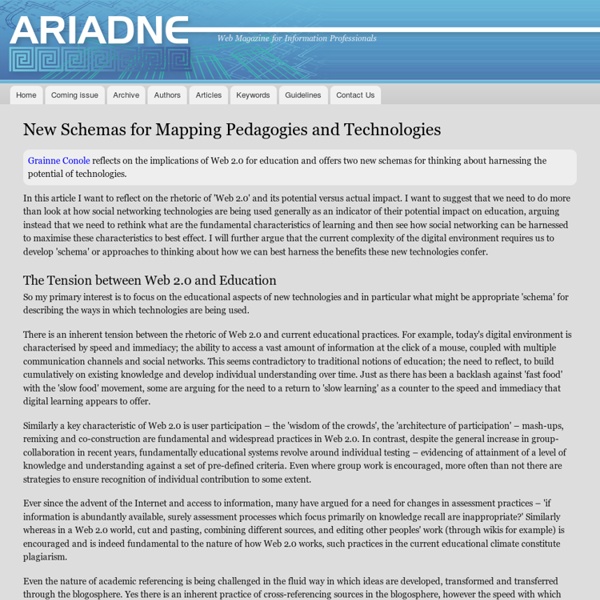Pontydysgu – Bridge to Learning - Educational Research
In March I wrote a paper on ‘The Future of Learning Environments; for a publication from the IATEL conference held in Darmstadt last year. I have been asked to produce a short verion of the paper for translation to German. Here it is. The Future of Learning Environments 1. The present ‘industrial’ schooling system is fast becoming dysfunctional, neither providing the skills and competences required in our economies nor corresponding to the ways in which we are using the procedural and social aspects of technology for learning and developing and sharing knowledge. One major impact of internet technologies has been to move access to learning and knowledge outside of institutional boundaries. Schools and universities can no longer claim a monopoly as seats of learning or of knowledge. Technology is also challenging traditional expert contributed disciplinary knowledge as embodied in school curricula. 2. The evolution of the school system can also be seen in terms of dominant media. 3. 4. 5.
The Differentiator
Try Respondo! → ← Back to Byrdseed.com The Differentiator The Differentiator is based on Bloom's Taxonomy, Kaplan and Gould's Depth and Complexity, and David Chung's product menu. Try It In: French Dutch • Tweet It • Like Byrdseed • Pin It Students will judge the ethics of the [click to edit] using a textbook and create an essay in groups of three. Revised Bloom's Taxonomy adapted from "A Taxonomy for Learning,Teaching, and Assessing: A Revision of Bloom's Taxonomy of Educational Objectives" by Anderson and Krathwohl Depth and Complexity adapted from The Flip Book by Sandra N. Depth Big Idea Unanswered Questions Ethics Patterns Rules Language of the Discipline Essential Details Trends Complexity Multiple Points Of View Change Over Time Across the Disciplines Imperatives Origin Convergence Parallels Paradox Contribution Key Words Consequences Motivations Implications Significance Adapted from David Chung and The Flip Book, Too by Sandra N. Group Size One Two Three Four
Blackboard Education Technology Platforms
Education Technology Solutions for All Blackboard's education technology platforms work to improve every aspect of the education experience. From universities to K12 classrooms to professional training and fully online learning environments, we have the technology and expertise to help you and your students succeed. Explore our platforms: Comprehensive Online Learning Tools The Blackboard Learn LMS is your home base for anything from posting materials online to a complete virtual learning environment and everything in between. Learn More Online Collaborative Learning More than a web conferencing tool, Blackboard Collaborate is a powerful all-in-one platform that gives you an immersive human experience via your PC, tablet, or mobile device, everywhere every time. Multi-Modal Alerts and Notifications Stay connected to your community with Blackboard Connect – your single mass notification solution for delivering everyday updates and emergency notifications. Campus Commerce and Security
Handbook of Online Learning: Innovations in Higher Education and Corporate Training (9780761924036): Kjell Erik Rudestam, Judith Schoenholtz-Read
What is a Learning Platform?
While I have written (along with others) about the shift we are seeing in the LMS market, where it is moving from an enterprise LMS market to a learning platform market, there has not really been a good definition of what a learning platform is. As Jeff Bohrer asked via Twitter, “What are the hallmarks of LMS as a “learning platform” (beyond SaaS)? Any posts you can point to?” Mike Zackrison offer some very helpful thoughts in his response of “A few I’ve observed: cloud, multi-tenant; open API; social, analytics, mobile baked in; apps/content discovery too”. Rather than reply within the limits of 140 characters, I’d like to offer a response here (I have trouble with being pithy). Platform Definitions First, let’s look at the metaphor. Given this context, there is a rather extensive Wikipedia entry on learning platforms with some useful definitions included. Hallmarks of a Learning Platform What are your thoughts on the definition and hallmarks of learning platforms? Google+ Comments
Rhizomatic Learning
For several years now, I have been considering how the rhizome might function as a metaphor for learning and a model for education. I tend to agree with Gilles Deleuze and Félix Guattari (2002) who in writing about the tree as the long standing metaphor for knowledge and learning said, “We’re tired of trees. We should stop believing in trees, roots, and radicles. They’ve made us suffer too much" (p. 15). In their stead, Deleuze and Guattari offer the rhizome. A month ago, my friend Jane, a professor at a Connecticut University posted this definition of rhizome: The rhizome is a tangle of tubers with no apparent beginning or end. So today as Scott Klepesch, Deb Gottsleben and I were visiting English teachers, Cathy Stutzman and Meg Donhauser and librarians Heather Hersey and Marci Zane from Hunterdon Central Regional High School (HCRHS) in NJ, I began to see what the rhizomatic classroom might resemble. Meg’s class is run like a choose-your-own British literature adventure!
Moving beyond self-directed learning: Network-directed learning
This site has been created to foster discussion on how our thinking, learning, and organizational activities are impacted through technology and societal changes. Since the original publication of Connectivism: A Learning Theory for the Digital Age, I've been approached by many people requesting additional thinking and discussion. Four tools are available to provide dialogue: Blog for my personal reflective thoughtsWiki for collaborative content creationDiscussion forums for discussion on issues impacted by a connectivist view of learningEmail list for discussions on technology, networks and learning Most resources on this site are intended for public viewing, but contributing to the wiki or discussion forums requires registration. Please create your account by clicking the "join" text on the top, right-hand corner. If you are interested in general learning and technology trends, please visit my elearnspace site.



